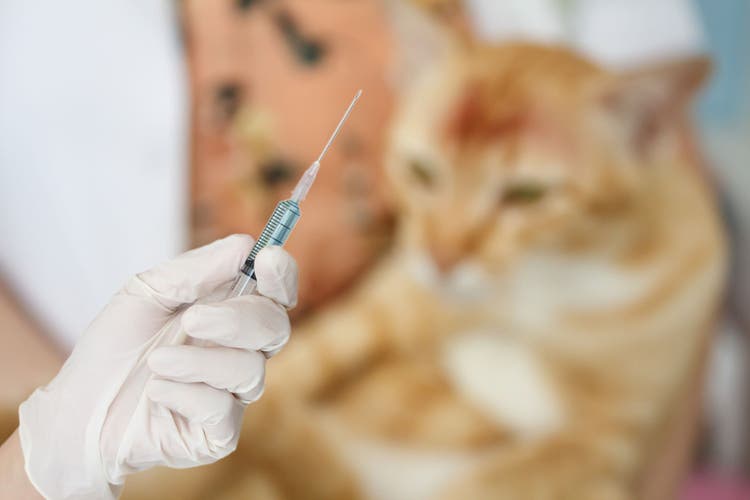
Nasal or Injectable – Which Vaccine is Best for Your Cat?
Recently, vaccination has become a very controversial subject. Gone are the simple days when your pet would receive a series of kitten shots and then shots every year. This was the typical method used to keep our pets healthy. But, with the advent of cancers and immune diseases thought to be associated with vaccination, the route of vaccine has become a hot topic.
Most people are familiar with the injectable vaccines. These commonly are used to protect from herpesvirus, panleukopenia, calicivirus, feline leukemia and rabies. One of the most devastating adverse responses to vaccination is the development of certain cancers. In the past few decades, sarcomas (a type of cancer) have been associated with certain vaccinations. The most commonly implicated vaccines are feline leukemia, rabies and killed rhinotracheitis (herpes), calicivirus and panleukopenia (FVRCP). The modified live version of the FVRCP vaccine is rarely thought to be a cause.
Recently, vaccines have become available that are applied topically, usually in the nose or eyes. Many of the topical vaccines are applied to the eyes and nose to help increase protection. There are disadvantages and advantages of each method of vaccination and topical vaccines are not available to protect against all diseases. For cats, nasal vaccines are available to protect against serious disease from rhinotracheitis (herpes), calicivirus and panleukopenia. Vaccines for herpes and calicivirus do not protect the cat from getting the disease. These vaccines are intended to reduce the severity of the illness if the cat does become infected. This protection applies to both injectable and nasal vaccines.
Advantages of Nasal Vaccines
The most important advantage of the topical vaccines is that this type will not cause vaccine-induced sarcoma, a potentially fatal cancer. Administration of rhinotracheitis and calicivirus vaccine to the eyes and nose may provide better protection, and more quickly, than injectable forms of the vaccine. Some studies have shown that protection from the nasal vaccine is about 2 to 3 days. For the typical injectable vaccination, it takes about 5 to 7 days for the vaccine to provide protection.
The topical form of rhinotracheitis and calicivirus have been used as part of the treatment for upper respiratory infection. Some veterinarians feel that the vaccine can help reduce the severity of illness when administered during an infection but this has not been proven.
Cats as young as 2 weeks of age can be vaccinated using the nasal/ocular vaccine. This is especially useful in orphan kittens and in catteries. The panleukopenia vaccine should not be given to any kitten under 8 to 12 weeks of age.
Disadvantages of Nasal Vaccines
The primary disadvantage of the nasal vaccine is the higher rate of side effects when compared to the injectable vaccine. After administration of the nasal vaccine, about 20 to 30 percent of cats may develop mild conjunctivitis, clear nasal discharge, sneezing, ulcers of the mouth and nose and fever. This may not develop for up to 2 to 3 days following vaccination and may last for 5 to 7 days.
Another disadvantage is that the topical vaccines may be difficult to administer to some cats. Certain cats may struggle or sneeze a lot as the vaccine is given. This often results in inadequate doses of vaccine and may not provide sufficient protection.
Nasal vaccines are not available for all diseases. Currently, rhinotracheitis, calicivirus and panleukopenia are the only viruses included in nasal vaccines. There is controversy regarding the panleukopenia part of the vaccine. Many feline veterinarians do not recommend giving panleukopenia vaccine as a topical vaccine.
Recommendations
Currently, it is recommended to vaccinate cats against rhinotracheitis (herpes), calicivirus, panleukopenia and rabies. Other vaccinations should be given only if the cat is at risk (feline leukemia, feline infectious peritonitis, ringworm, chlamydia). If a very young kittens needs to be vaccinated (less than 8 weeks of age), a nasal vaccine with rhinotracheitis and calicivirus can be used. Panleukopenia should not be given until the kitten is at least 8 weeks old to prevent illness associated with the vaccine. Cats in shelter situations or catteries may benefit from nasal vaccines.
Since the nasal vaccines are modified live vaccines, they are not recommended in cats with feline leukemia, feline immunodeficiency virus or cats that will soon undergo stressful situations, such as surgery. Be aware that for all vaccines, it is important to vaccinate at least 5 days before potential exposure. Vaccines do not work immediately. It takes time for the body to respond to the vaccine, develop immunity and provide protection against the specific disease.
Whether nasal vaccine is used to prevent serious illness associated with rhinotracheitis and calicivirus or the injectable form is used will depend on the cat and the vaccines available. Discuss the advantages and disadvantages with your veterinarian.